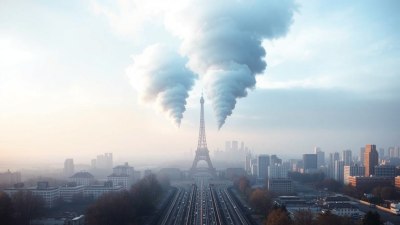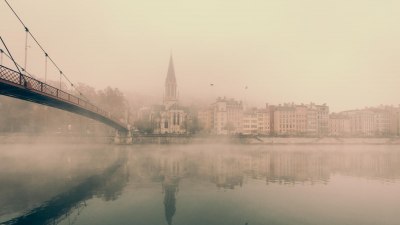What Causes Temperature Inversions and City Smog
Explore the causes of temperature inversions and their role in city smog formation, including atmospheric conditions and pollution effects.

Image created with Flux Schnell
Temperature inversions and city smog are interrelated atmospheric phenomena that significantly impact urban air quality and public health. Understanding their causes helps in developing strategies to mitigate pollution and improve living conditions in cities worldwide.
Understanding Temperature Inversions
A temperature inversion occurs when the normal temperature profile of the atmosphere is reversed. Under typical conditions, air temperature decreases with altitude—warmer air near the ground and cooler air above. During an inversion, however, a layer of cooler air is trapped near the surface beneath a layer of warmer air.
This reversal inhibits the normal vertical mixing of air layers. Instead of pollutants dispersing upward and diluting, they remain concentrated near the surface. This trapping effect can lead to significant increases in local pollution density, creating conditions ripe for smog formation.
The Natural Causes of Temperature Inversions
Several natural atmospheric conditions contribute to the formation of temperature inversions. One of the most common causes is radiational cooling during calm, clear nights. After sunset, the Earth's surface quickly loses heat through radiation, cooling the air directly above it while the air at higher altitudes remains warmer.
Valley regions are especially prone to radiational inversions. Cool air, being denser, settles into low-lying areas, while warmer air stays above. This geographic effect can cause prolonged inversion events in terrain surrounded by hills or mountains.
Another cause includes subsidence inversions, which arise when a large mass of air descends slowly, compressing and warming as it lowers. This descending air forms a warm lid above cooler air near the surface, trapping it below.
Urban Environments and Inversion Formation
Cities often experience temperature inversions more frequently due to their unique environments. The urban heat island effect, where concrete and asphalt absorb and re-emit heat, can alter local atmospheric conditions. However, at night, urban surfaces can cool rapidly, fostering conditions for inversions.
Additionally, tall buildings and structures can disrupt airflow, limiting horizontal and vertical air movement. This architectural influence can exacerbate inversion conditions by reducing natural ventilation that helps disperse pollutants.
What is Smog and How It Forms
Smog is a combination of smoke and fog, resulting from the interaction of pollutants with sunlight and atmospheric moisture. There are two main types: classical smog and photochemical smog. Classical smog, or sulfurous smog, typically occurs in cooler, damp climates and is characterized by high concentrations of sulfur dioxide and particulate matter.
Photochemical smog, more common in sunny, warm cities, forms when nitrogen oxides (NOx) and volatile organic compounds (VOCs) react with sunlight to produce ground-level ozone and other oxidants. This type is often visible as a brownish haze.
How Temperature Inversions Enhance Smog Formation
Temperature inversions play a critical role in smog formation by trapping pollutants near the Earth's surface. When inversion layers prevent vertical air mixing, emissions from vehicles, industry, and other urban sources accumulate in a concentrated layer.
During daylight, strong sunlight drives photochemical reactions between trapped pollutants, producing harmful ozone and secondary particles that contribute to smog. The prolonged presence of these layers leads to sustained poor air quality and health risks.
Sources of Pollutants That Contribute to Smog
Urban centers produce a wide array of pollutants that fuel smog development under inversion conditions. Primary sources include vehicle exhaust, which emits nitrogen oxides, carbon monoxide, and VOCs. Industrial plants add sulfur dioxide, particulate matter, and additional VOCs to the mix.
Other contributors include fuel combustion in power generation, residential heating, and even construction activities. When these combine with favorable meteorological conditions, smog episodes can become severe and persistent.
Health and Environmental Impacts of Temperature Inversions and Smog
High pollution levels trapped under inversion layers pose serious health risks. Fine particulate matter can penetrate deep into the lungs, aggravating respiratory illnesses, heart disease, and increasing mortality rates. Ground-level ozone causes irritation, reduces lung function, and exacerbates asthma.
Environmental consequences include damage to vegetation, reduced visibility, and harmful impacts on wildlife. Smog can inhibit photosynthesis and cause acid rain, which further harms soil and aquatic ecosystems.
Monitoring and Predicting Inversions and Smog Events
Meteorologists use various tools to detect temperature inversions and predict smog events. Radiosondes and atmospheric profilers collect temperature and wind data at different altitudes. Satellite imagery can observe pollutant distribution and thermal structures.
Air quality monitoring stations measure concentrations of key pollutants, providing real-time data to warn residents and authorities. Forecasting models combine environmental and emission data to estimate inversion intensity and smog severity, allowing for proactive public health advisories.
Strategies for Managing and Reducing Smog
Effective smog management involves both reducing emissions and mitigating the effects of temperature inversions. Urban planning to improve airflow and reduce heat islands helps limit inversion intensities. Public transportation and cleaner vehicle technologies can reduce pollutant output.
Regulatory measures, such as emission limits for industries and enforcement of air quality standards, are vital. Promoting renewable energy sources and energy efficiency further decreases the pollutant load that fuels smog formation.
Global Examples of Temperature Inversion and Smog Incidents
Many cities around the world have faced severe smog episodes linked to temperature inversions. For instance, Los Angeles frequently experiences photochemical smog exacerbated by coastal inversions and heavy traffic emissions.
Beijing has struggled with inversion-related smog, especially during winter months when coal burning increases particulate pollution and inversions are more stable. Similar issues occur in cities like Mexico City, London, and New Delhi, highlighting the global challenge of managing air quality in the face of complex atmospheric dynamics.
Future Challenges and Research Directions
As urban populations grow and climate patterns shift, understanding temperature inversions and smog formation remains critical. Research focuses on improved atmospheric modeling to predict inversions more accurately and the development of advanced pollution control technologies.
Long-term solutions involve combining scientific insights with urban design innovations, public policy, and community engagement to create healthier environments. The interplay between climate change and inversion frequency is also being studied to anticipate future air quality scenarios.
Addressing the root causes of pollution and adapting to atmospheric conditions will be essential to protecting health and the environment as urbanization continues worldwide.











